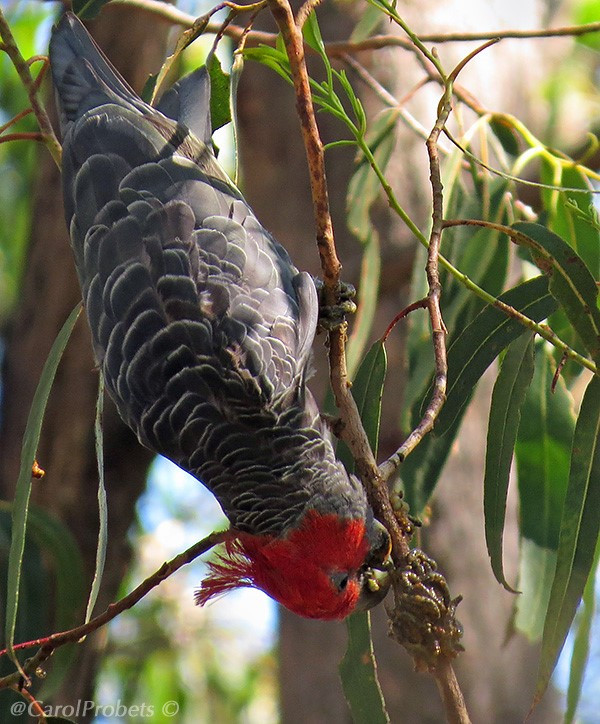There are some relatively common birds that I find exciting and wondrous to see every single time – Wedge-tailed Eagles, Yellow-tailed Black Cockatoos, Crested Shrike-tits – and of course everyone’s favourite stocky grey cockatoo with the whispy little crest- the Gang-gang Cockatoo!
I had the great pleasure of writing a feature article on this species for the September issue of Australian Birdlife magazine ( my workplace). I interviewed Carol Probets, a naturalist from the Blue Mountains area, and Chris Davey from the Canberra Ornithologists Group by phone. And had an email interview with Stephen Garnett, one of Australia’s leading ornithologists and currently very busy preparing the 2021 Action Plan for Australian Birds.
I gathered enough material and read enough scientific papers for a whole chapter on these lovely birds! I was pleased with the published result – but due to space constraints a fair bit had to be cut out. So this blog’s purpose is twofold – to share the article with you, my lovely readers, if you are not already a subscriber, and to add in a fascinating bit about an unusual food preference that was unpublished.
“Meet the Gang-gang” can be found here. The whole September issue can be read online here – but to really enjoy this gorgeous magazine – become a member or a wildbird protector and get the print edition! : )

Spitfires – “delicious” tucker!
Gang-gangs are not as conspicuous as other members of the cockatoo family. It is often the sound of their distinctive creaking calls, or the gentle patter of half eaten gum nuts falling from high in the tree canopy that indicates their presence. They may also growl quietly and contentedly whilst eating.
They feed primarily on the seeds of eucalypts and wattles; and the fruits of introduced plants such as Hawthorn. Like other forest and woodland cockatoos, gang gangs also eat insects and their larvae. The Gang-gang is one of the few birds that eats sawfly larvae – they may work their way through a whole clump!
Carol Probets, long term resident of the Blue Mountains, and member of the Blue Mountains Bird Observers (BMBO) group has captured this foraging behaviour on camera.
Carol watched the male Gang-gang manipulate the grub with its left foot, and then eat the soft inner parts of the grub, discarding the skin and head, before reaching out for the next “tasty” morsel. Also known as spitfires for their protective mechanism of ejecting noxious liquid onto attackers, Carol noted that the spitfires’ excretions seemed to have no effect whatsoever on the foraging Gang-gangs!

Ellen McCulloch recorded some detailed observations on this behaviour in 1972 in Australian Bird Watcher magazine (you can read it here ). Ellen saw gang gangs foraging from clumps of saw fly larvae, and also picking off individuals – which she says were also known as “spitty grubs”. Ellen writes:
“Knowing of the general inquisitiveness of the parrot family I
thought it possible that the birds may have only been investigating,
not eating, but evidently this was not so. One bird regularly perched
only three feet from a house window and was closely watched.”
For general info on sawflies – Australian Museum, and Brisbane Insects has some cool photos of another predator of sawflies – albeit much smaller – a tachinid fly. These flies lay their eggs on the sawflies’ bodies and then eat them while they alive – but that’s a whole other blog post. haha
I haven’t seen many Gang-gangs around here this year – a few years ago I had the absolute pleasure of a our bush block hosting a visiting family for months…
This species’ range (eastern Australia) corresponds very much with the extensive Black Summer bushfires, and consequently, the species’ status is being upgraded from Least Concern to Vulnerable in the Action Plan for Australian Birds. Their movements are described as partly migratory, and like so many aspects of this little known cocky – poorly understood. This means any sightings you have are really important to record – whether you use Birdata or E-bird.
A fun fact to end on – A Canberra Ornithologists Group citizen science study on Gang-gang breeding behaviour reveals that these sweet birds seem to nest in little communes!
“Nesting sites tended to be close to each other and several observers recorded peaceful and what seemed to be helpful interactions between nearby nesting Gang-gang pairs, such as neighbouring Gang-gangs driving off another bird species from an unattended hollow, nesting pairs calling to each other and flying off together, or nesting pairs visiting each other’s hollows.” ( Canberra Ornithologists Group Report Unpb)
What bird book do you recommend that also includes eggs descriptions or photos (Aussie birds)?
________________________________
Hi Mary – the only Bird Guide book I know of that has eggs and nests is Michael Morcombe’s Field Guide to Australian Birds